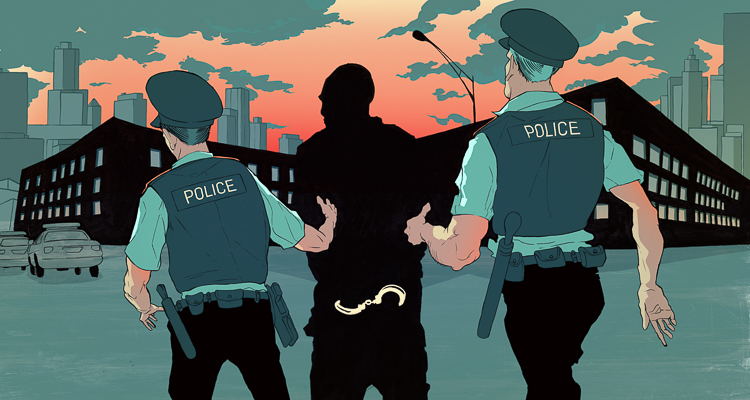BY: M. TOMOSKI
Illustration by: Ryan Garcia / The Plaid Zebra
It’s a fine line to walk between tin-foil hats and hard facts whenever you hear the words “the government is hiding something.” In most cases, these are the people who force us to avoid eye contact and cross to the other side of the street. But that same brand of skepticism also explains why it took so long to accept that Japanese-Americans and their families were held in prison camps as potential spies for the Emperor during WWII. The same can be said for the secret Chicago prison operating today.
Stories of secret prisons are often suspicious and–if we think about them at all–we would like to think that America keeps that sort of shameful behavior in the historical rearview–or at least well away from its own shores. Yet, every once in a while, bitter reality crawls to where we live and bites us.
According to documents released last year through a Freedom of Information Act (FOIA) lawsuit filed by the Guardian, more than 7,000 people disappeared between 2004 and 2015 into a nameless red warehouse in Chicago to be interrogated without an attorney, with no way to contact family. The ongoing investigation, launched by journalist Spencer Ackerman, has shown that officers in the warehouse used physical force on at least 14 men and that at least two have died in custody. That detention centre, known as Homan Square, has existed since the late ’90s.
Chicago police largely from the Bureau of Organized Crime, who work within the building, have officially stated that “it is not a secret facility,” despite very few records of the warehouse or the prisoners there existing on the department’s official database.
In a deposition last September, Chicago police officer Randolph Nichols said that the department had “just created a unit the other day for Homan Square arrest processing.” According to the Guardian’s investigation, the department only provided 275 digital records out of over 7,000 arrests for the facility.
The Chicago police did not respond to a request for comment, but a ‘fact sheet‘ they released to address the issue claims, “inaccurate and misleading information regarding Homan Square has been making its way around the Internet.”
Insisting that the label of ‘black site prison’ is an exaggeration, the department attempted to shed some light on the issue by saying that secrecy surrounding Homan Square is maintained to protect the identity of their undercover officers. “Advertising their base of operations,” the statement said, “could put their lives at risk, which is why Homan Square features little signage.”
But the testimonies of former prisoners and officers who are familiar with the facility suggest that Homan Square might be better described as a base with nearly two decades of questionable conduct.
Only 86 visits from attorneys were ever recorded at the site. Narcotics officer William Kilroy remembers seeing far less. When asked in a deposition of the facility’s standard practice when a prisoner at Homan requests to see a lawyer, Kilroy said:
“Well at that point, we will just take him to the 11th District, and then he can call from there. We don’t have facilities for them to make pay-phone calls from ours – we’re not set up as a booking facility. We’re just a temporary holding facility.”
When asked how a prisoner could notify a family member that they are being held at Homan, he replied, “I don’t know that you can.”
In addition to limiting prisoners’ access to legal counsel and their communication with the outside world, former prisoners and FOIA documents revealed that officers might also have engaged in abusive practices while holding and interrogating suspects at the warehouse. In the case of one detainee who claimed to have been strangled by officers with a zip-tie around his neck, the department did not deny the incident, but insisted that the man had somehow managed to tie the device around his own neck while he was restrained.
“The allegation that physical violence is a part of interviews with suspects is unequivocally false,” the department official statement read. “It is offensive, and it is not supported by any facts whatsoever.”
Will Potter, an investigative journalist and author of Green is the New Red, has been uncovering domestic black sites years before the Homan story broke. He told the The Plaid Zebra that “the United States has a long history of prison units like this” and that the Chicago warehouse is not the only one.
A similar prison unit in Terre Haute, Indiana, is referred to by guards as “Little Guantanamo” and is officially known as Communications Management Units (CMU), which are hidden within the regular prison system. Although Homan Square is not considered a CMU, it appears to operate on the same shady level.
According to the CMU prisoner lists Potter obtained through FOIA, only religion and ethnicity are revealed, while the name of every prisoner on the list was redacted.
“It should disturb everyone that the US government would try to redact the names of all prisoners in any prison,” Potter suggests. “There’s absolutely no reason to keep it secret, unless people’s rights are being violated.”
In their official statement, the Chicago police have insisted that Homan Square is a base of operations for their narcotics unit and that the warehouse’s primary purpose is to combat drug trafficking.
“The Chicago Police are being dishonest if they’ve made that statement,” Potter said, pointing out that Brent Betterly, Jared Chase, and Brian Jacob Church, a group of protesters identified by law enforcement as the NATO 3, are known to have been brought to the site. In fact, Homan’s exposure by Ackerman was the result of an investigation into the protestors who were arrested on terrorism charges after demonstrations at a 2012 NATO summit in Chicago.
As revealed in depositions and documents from the department, other Homan prisoners include people pulled off the street to be informants, as well as at least 11 people who were taken in for bootlegging CDs and movies.
“In my reporting I’ve seen and interviewed environmentalists and animal rights activists who have been housed [in CMUs] and are housed there right now,” Will said, recalling the story of Daniel McGowan, who was tried for committing arson as a member of the environmental activist group, the Earth Liberation Front. After his conviction, McGowan’s lawyer told the judge that his client would be sent to a CMU if he was sentenced as a domestic terrorist. The judge dismissed the lawyer’s concerns and suggested that they were based on rumors.
According to Potter, “It’s possible that the judge didn’t even know about it or just didn’t believe that that could be a possibility, but that’s exactly what happened.”
When Potter became the first reporter to be granted access to a CMU, much of his conversation with Daniel was limited to books, movies and ordinary small talk. Being confined to a tiny room, divided by a foggy pane of glass and recorded at all times, any questions that Will asked could potentially make an already horrifying experience more difficult for McGowan.
“[T]here was a real concern that if I [reported on him], it would cause serious repercussions for him while he’s already facing significant hardship,” Will explained.
In the past, the FBI has referred to environmental activists as the number one domestic terrorist threat, but former prisoners at these facilities claim to have overheard conversations between guards in which they referred to white prisoners as, “balancers” to avoid legal action for the overwhelmingly Muslim population of the prisons.
“It certainly looks like that is the intention,” Potter said, but he also claims that there has been “considerable pressure from corporations and industry groups to label environmentalists and other activists [as terrorists],” referring to laws that have come to be known as Ag-gag measures, which the agricultural industry heavily lobbies governments to enact.
Potter admits that environmentalists and animal rights activists have committed crimes, pointing to vandalism and arson, which he considers extremely dangerous, but he also says “it’s important to note that in the history of these movements no human being has ever been injured and that’s not an accident.”
The only reported injury caused by the actions of environmentalists came from an anti-logging tactic known as tree spiking. In 1987, a California logger named George Alexander had his chainsaw shattered on a spike planted by the Earth First movement. While the tactic is not intended to cause harm to the worker (only the equipment), the incident caused spiking to become a federal offence and gave rise to the term ‘Eco-terrorism.’
“This rhetoric of terrorism is really reclassifying people within prisons, and I think that’s a dangerous pattern,” Potter said. “Yes, environmentalists have committed crimes, but does that warrant classifying them in the same way as we would the 9/11 hijackers?”
He fears that sort of classification will change the way a prisoner is treated and that the public will turn a blind eye to or accept the punishment as appropriate.
Yet even with the exposure of black site prisons by independent journalists, publications like the Guardian, and NGOs like the ACLU and the Columbia Journalism Review note that the story of Homan Square got very minimal coverage, especially among local papers.
Despite the evidence The Guardian provided, Chicago newspapers were highly skeptical of the story and even made mention of the fact that The Guardian is a British newspaper even though the reporter was an American.
In one of the few articles to cover the story The Chicago Tribune said that, “Homan Square is not any more of an off-the-books location than any other facility, said one investigator who spoke on condition of anonymity because he was not authorized to talk.” Although, it’s not clear why the investigator would not be authorized to speak about a location that isn’t meant to remain secret.
“There’s sometimes an eagerness from the general public, and reporters as well, to dismiss it as something that’s a fringe or concocted story that’s not grounded in reality,” Potter said, but he believes that we’ve reached a point where secret prisons and black sites have become far easier to expose, and with so much information available, the only question now is how much we’re willing to do to put an end to these types of practices.
“That viral component holds enormous potential. Whether that’s enough to pressure government agencies to change their policies remains to be seen, but I think it’s a starting point,” Potter adds.
Records from the Bureau of Prisons show that the federal government is clearly aware of the existence of secret facilities and CMUs and have outlined that their purpose is to hold prisoners deemed to have “inspirational significance,” which is extremely vague wording even for a legal document.
In officer Kilroy’s deposition, he also revealed that local police have cooperated with the federal government at Homan Square, and when asked about the warehouse while investigating the use of violence by Chicago police, Attorney General Loretta Lynch left the door open to a possible investigation, saying “we always reserve the right to expand [our investigation] should more information come to light and require a review of constitutional issues there as well.”
The Department of Justice did not respond to questions of whether an investigation into Homan Square would be opened after FOIA documents revealed injuries and deaths reported at the site. So for the time being, it would appear that the viral component is the last best hope for prisoners trapped in places that don’t exist.


